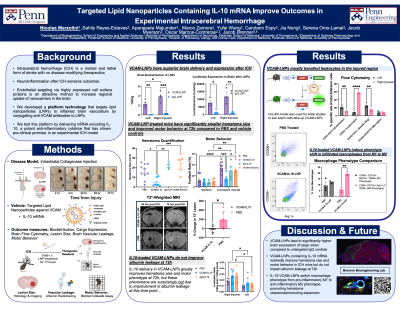Nanomedicine and Nanoscale Delivery (Focus Group - NND)
(333) Targeted IL-10 mRNA Lipid Nanoparticles Improve Outcomes in Experimental Intracerebral Hemorrhage

Introduction: Intracerebral hemorrhage (ICH) is a lethal and highly morbid stroke subtype lacking disease-specific treatment (1). Inflammation after ICH is an important mechanism of secondary damage, and the inflamed endothelium in ICH is a promising therapeutic target as it is the gateway for inflammation into the brain (2). We hypothesized that targeting mRNA encoding IL-10, a potent anti-inflammatory therapy, to the brain endothelium via vascular cellular adhesion molecule (VCAM)-targeted lipid nanoparticles (LNPs) would lead to improved outcomes in an experimental mouse model of ICH.
Learning Objectives:
- Describe the therapeutic effect of targeted IL-10 mRNA delivery in experimental ICH.
- Understand the novel insights into ICH pathophysiology uncovered in this study.
- Generalize the use of VCAM-LNPs as a platform technology to treat other neurological diseases.
Aparajeeta Mujamder, B.S. – Research Specialist, University of Pennsylvania; Sahily Reyes-Esteves, MD, PhD – Physician-Scientist, University of Pennsylvania

Nicolas R. Marzolini (he/him/his)
MD/PhD Candidate
University of Pennsylvania
PHILADELPHIA, Pennsylvania, United States

